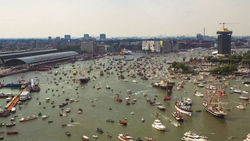Amsterdam Port Transhipment Down 4.8% in 1H 2018

Transhipment in the North Sea Canal Area at the seaports Amsterdam, IJmuiden, Beverwijk and Zaanstad declined to 49.4 million tonnes in the first half of 2018, a decrease of 5.1%. The Port of Amsterdam saw transhipment fall by 4.8% to 40.2 million tonnes.
In IJmuiden, transhipment declined to 9.3 million tonnes (-4.4%), Beverwijk registered a decline to 282,000 tonnes (-18.6%) and in Zaanstad transhipment fell to 84,000 tonnes (-59.3%).
The decline in Amsterdam in the first half of the year was due to two cargo flows: coal and oil products. Transhipment of coal was down 25.5% in the first six months of 2018 to 6.4 million tonnes. Transhipment of oil products also declined by 6.7% to 22.1 million tonnes. The latter decline was due to factors including maintenance at one of the terminals and reduced trading in the futures market, especially for diesel.
There were significant increases to offset the decline in these cargo flows. Transhipment of other dry bulk cargo in Amsterdam was up 16.8% to 5.2 million tonnes due to much higher imports of construction materials such as sand and gravel. Transhipment of agribulk was up 18.5% in the first half of the year to 3.9 million tonnes. Transhipment of other breakbulk, including RoRo, was down 1.6% to 889,000 tonnes. Container transhipment rose 29.6% to 454,000 tonnes (45,457 TEU), partly due to the arrival of Samskip, which operates a liner service to England. The increase in container transhipment is also reflected in the number of ships’ visits, which rose to 2514 (+4.4%).
The number of sea cruise ships visiting Amsterdam in the first half of the year amounted to 74 (compared to 53 in the previous year). The number of river cruise ships rose to 1,272 in the first half of 2018 (+25%), compared to 1,015 in the same period in the previous year. Koen Overtoom, CEO Port of Amsterdam: ‘The construction boom in the Netherlands is clearly visible in the sharp increase in other dry bulk cargo, which includes sand and gravel.
The arrival of Samskip also entails strong growth in container transhipment for us and we are seeing strong development in the short sea niche, an area we are focusing on. We expect to see further growth in these segments during the rest of the year. Whether the decline in oil products will continue is difficult to predict. We are a truly international trading port, meaning that geopolitical developments affect the volumes that pass through our port. Oil products continue to be an important cargo flow for us at this time.’